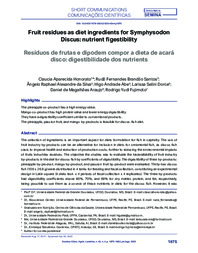Fruit residues as diet ingredients for Symphysodon Discus: nutrient figestibility.
Fruit residues as diet ingredients for Symphysodon Discus: nutrient figestibility.
Authorship: HONORATO, C. A.; SANTOS. R. F. B.; SILVA, A. R. A. da; ABE, H. A.; DORCE, L. S.; ARAUJO, D. de M.; FUJIMOTO, R. Y.
Summary: The selection of ingredients is an important aspect for diets formulation for fish in captivity. The use of fruit industry by-products can be an alternative for inclusion in diets for ornamental fish, as discus fish case, to improve health and reduction of production costs, further to reducing the environmental impacts of fruits industries residues. The objective the studies was to evaluate the bioavailability of fruit industry by-products in the diet for discus fish by coefficients of digestibility. The digestibility of three by-products: pineapple by-product, mango by-product, and passion fruit by-product were evaluated. Thirty-two discus fish (106 ± 26.6 g) were distributed in 4 tanks for feeding and fecal collection, constituting an experimental design in Latin square (4 diets test- x 4 periods of fecal collection x 4 replicates). The three by-products had digestibility coefficients above 80%, 70%, and 69% for dry matter, protein, and fat, respectively, being possible to use them as a source of these nutrients in diets for the discus fish. However, it was observed that the mango and passion fruit by-product had the lowest energy digestibility coefficient, with bioavailabilities less than 50% of utilization. The co-products of the fruit processing industry tested in this work have nutritional conditions to be used as food for root discs. The use of these co-products as food for ornamental fish can be an alternative use and value. O uso de coprodutos como componentes de uma ração fornece compostos bioativos, sendo economicamente acessível e ecologicamente viável. Neste sentido, o objetivo do estudo foi avaliar a biodisponibilidade de coprodutos da indústria de frutas na alimentação de acarás disco (Symphysodon aequifasciatus) determinando-se os coeficientes de digestibilidade dos macronutrientes. Foram avaliados a digestibilidade de três coprodutos: coproduto de abacaxi (Co-Ab), coproduto de manga (Co-Mg) e coproduto de maracujá (Co-Ma). Foram utilizados 32 acarás disco (106.0 ± 26.6 g) distribuídos em 4 incubadoras, constituindo-se de um delineamento experimental em quadrado latino (3 dietas-teste x 4 períodos de coleta de fezes x 4 repetições). Os coprodutos apresentaram coeficientes de digestibilidade acima de 82% para matéria seca, proteína e extrato etéreo, sendo possível sua utilização como fonte desses nutrientes em dietas para o acará disco. Porém os coprodutos de manga e de maracujá apresentaram os menores aproveitamentos com relação ao coeficiente de digestibilidade para energia, com biodisponibilidades menores de 50% de aproveitamento. Os coprodutos da indústria processadorade frutas testados neste trabalho possuem condições nutricionais para serem utilizados como alimento para acará disco. A utilização destes coprodutos como alimento para peixes ornamentais podem ser uma alternativa de uso e agregação de valor.
Publication year: 2022
Types of publication: Journal article
Keywords: Acara, Alimentação, Fish, Fish nutrition, Fruits, Nutrição Animal, Peixe, Resíduo
Observation
Some of Embrapa's publications are published as ePub files. To read them, use or download one of the following free software options to your computer or mobile device. Android: Google Play Books; IOS: iBooks; Windows and Linux: Calibre.
Access other publications
Access the Agricultural Research Database (BDPA) to consult Embrapa's full library collection and records.
Visit Embrapa Bookstore to purchase books and other publications sold by Embrapa.

